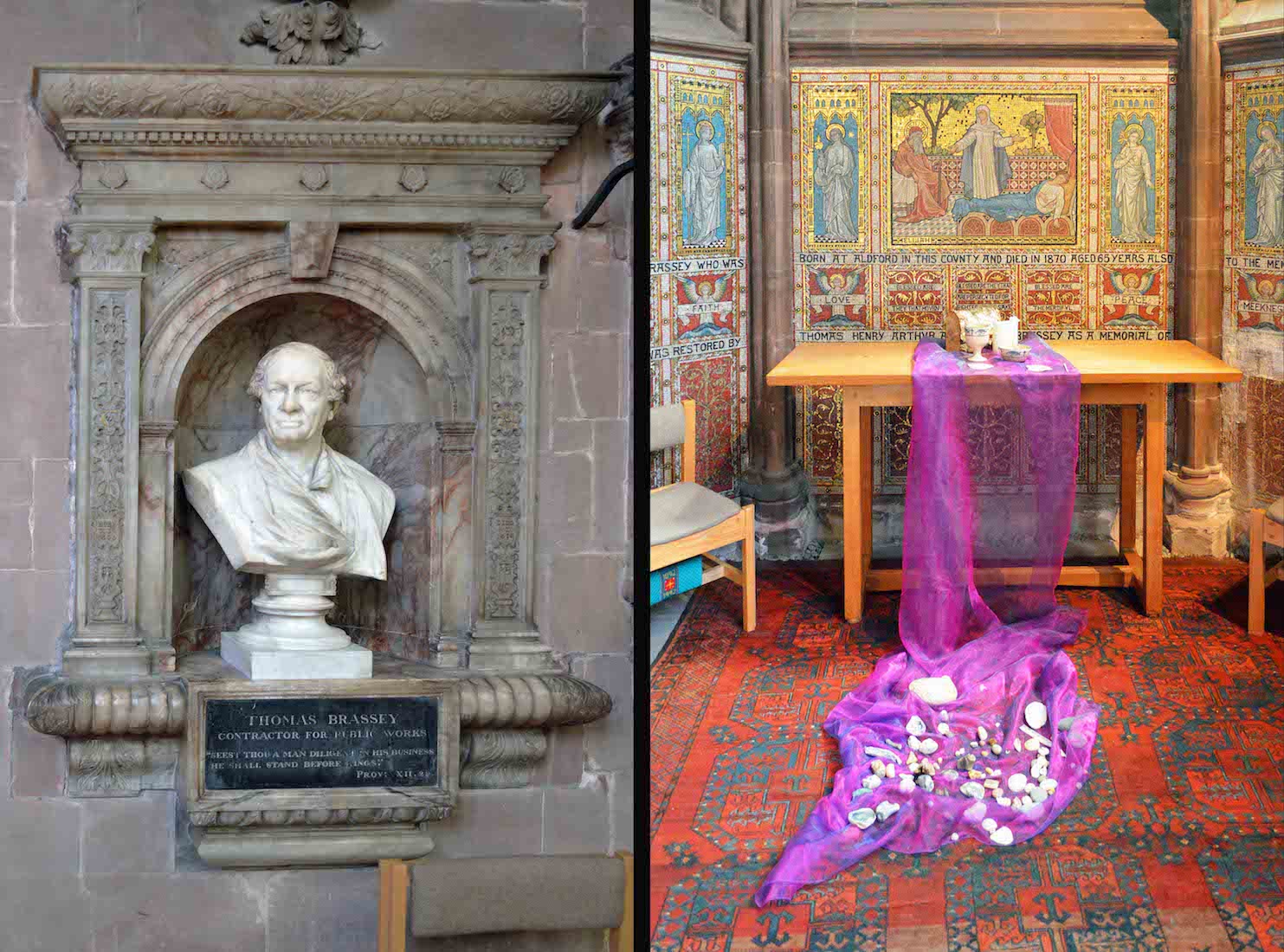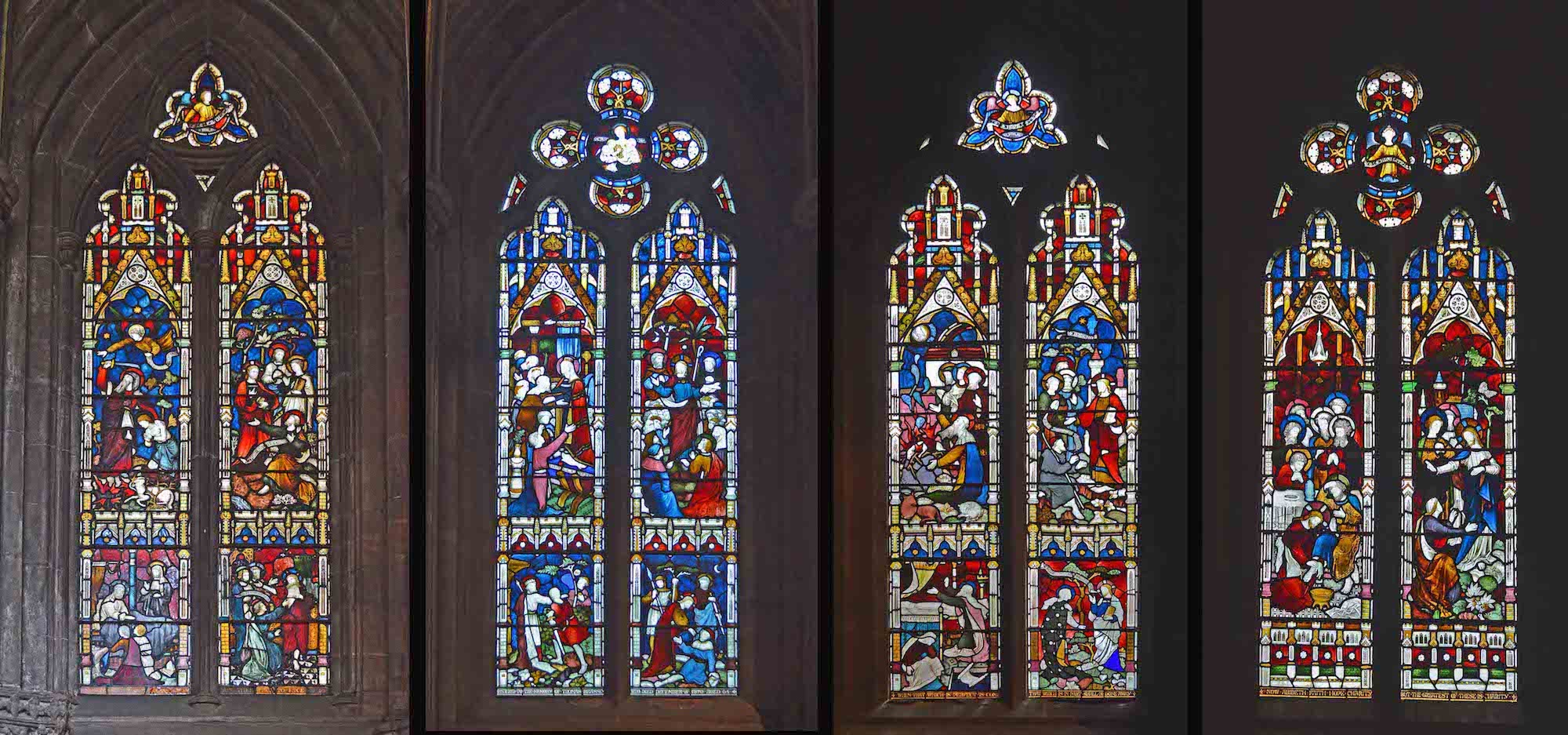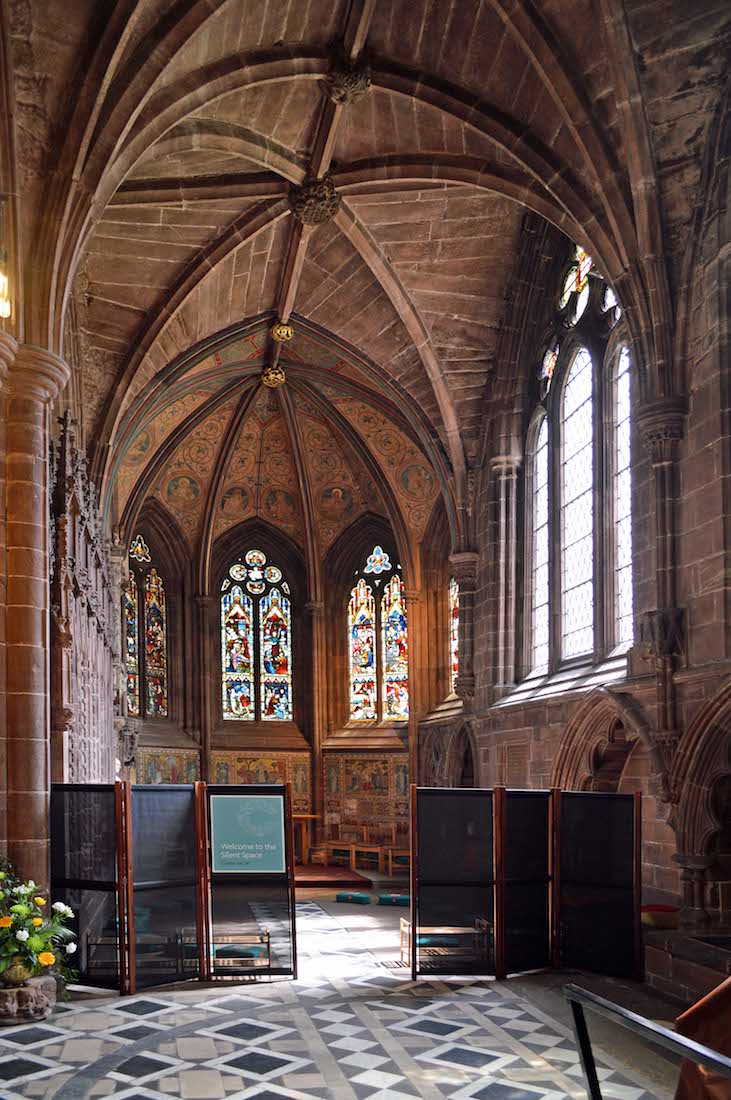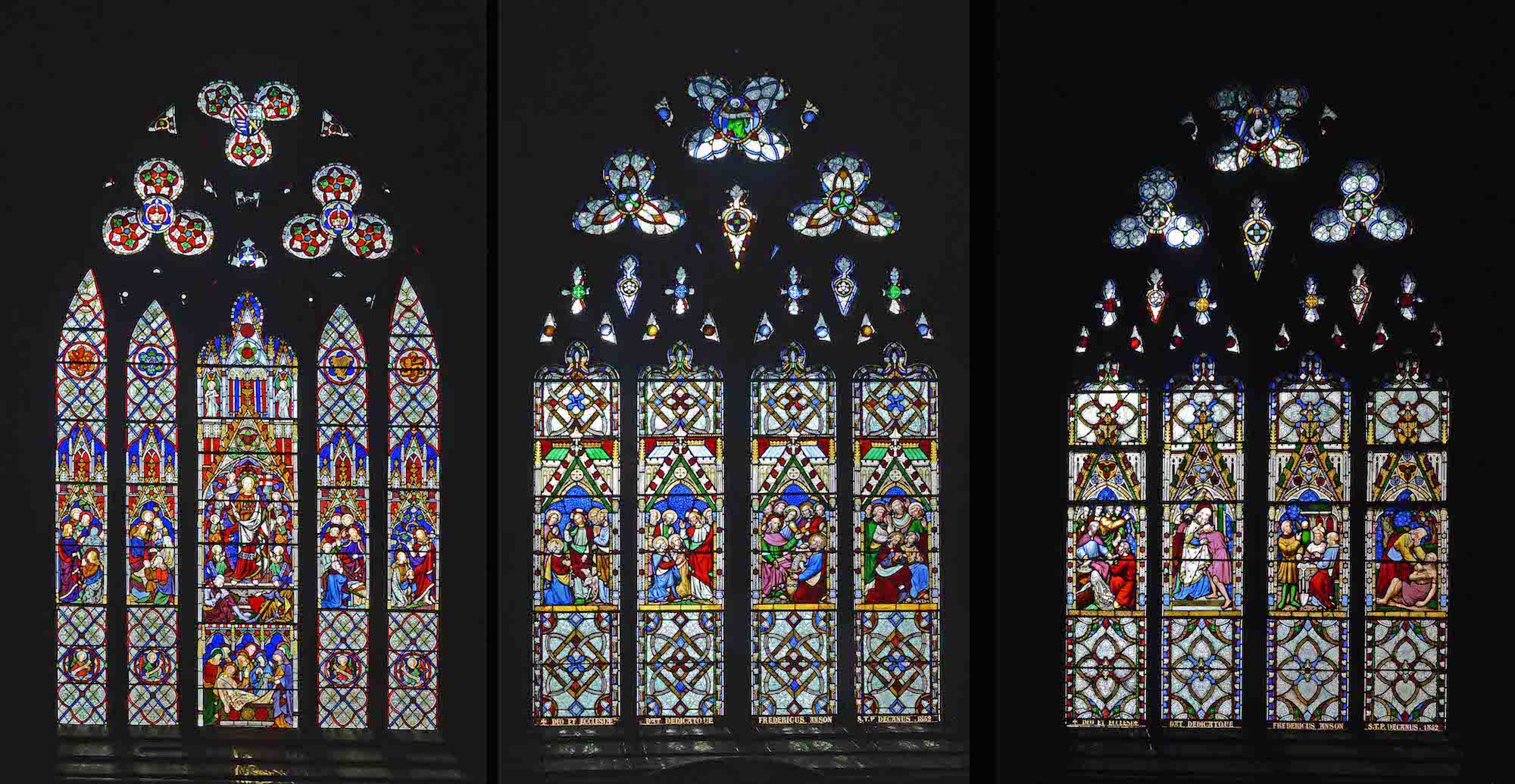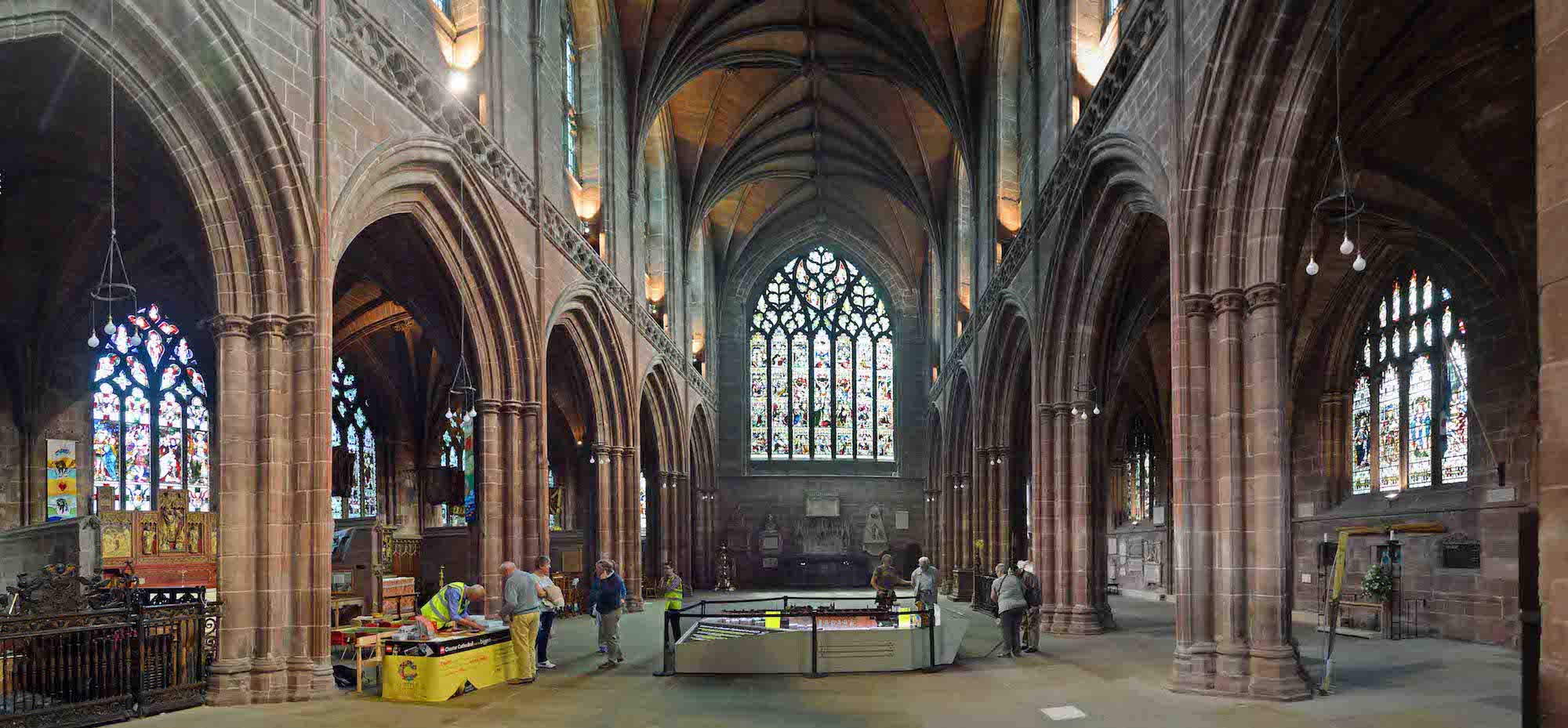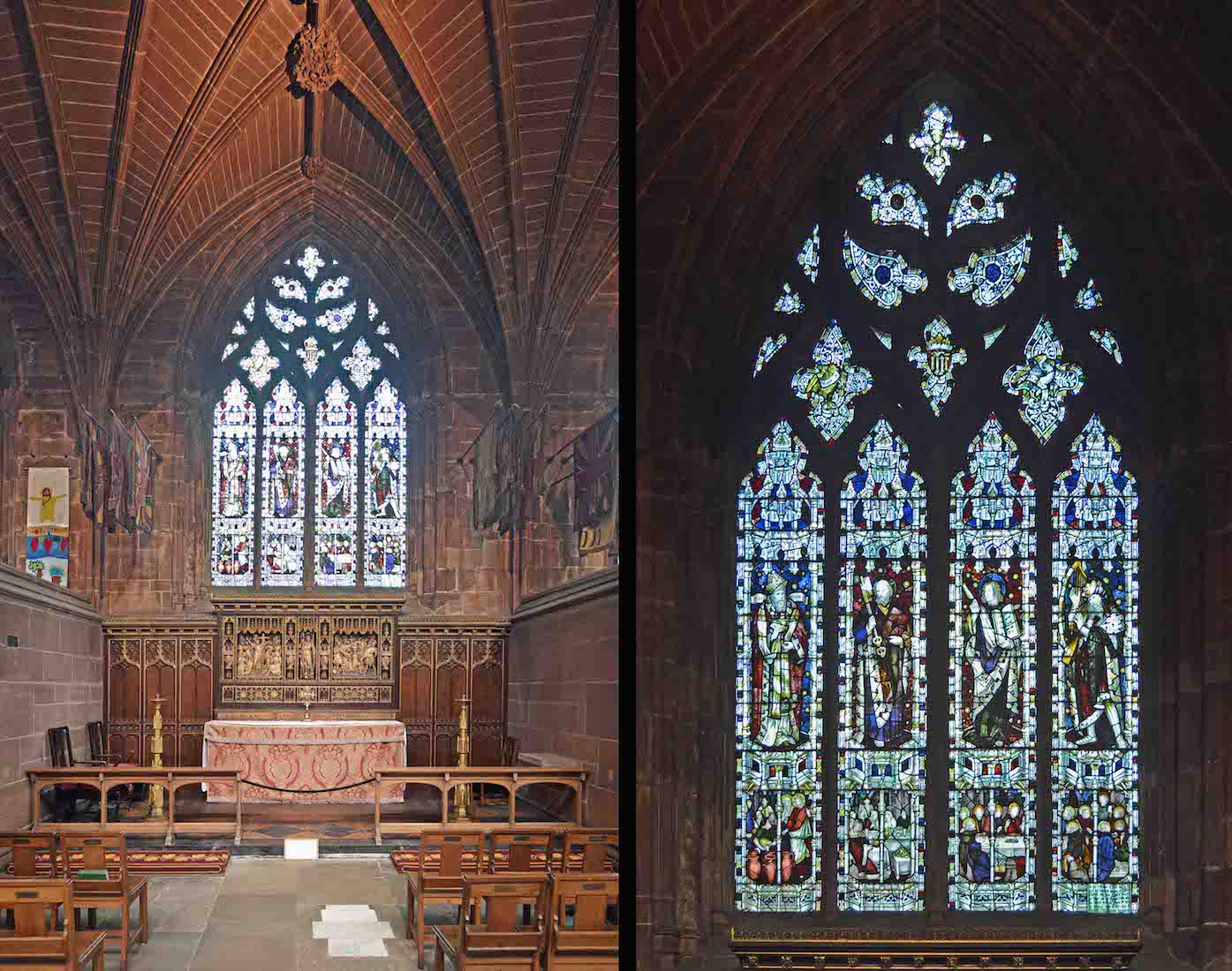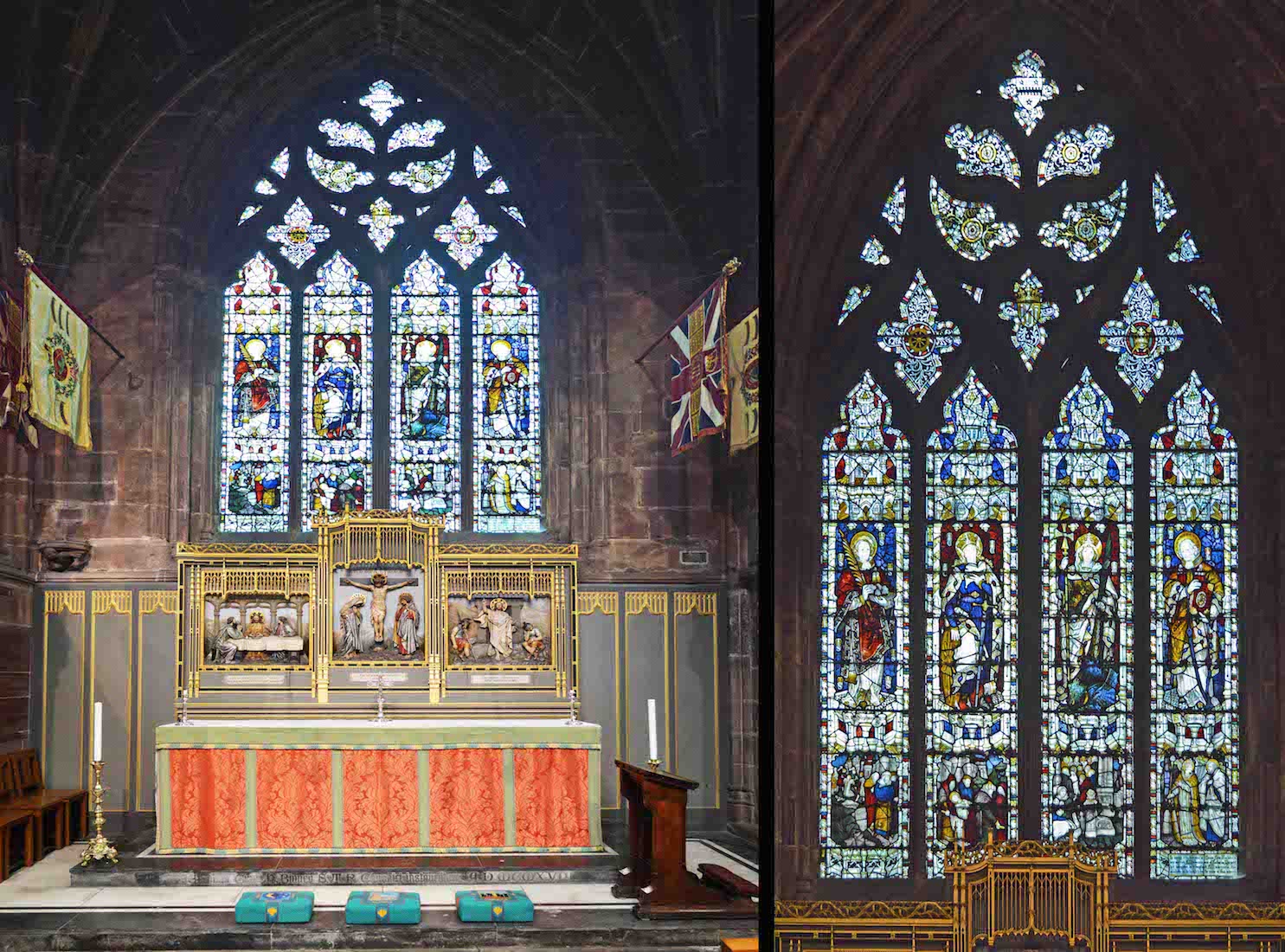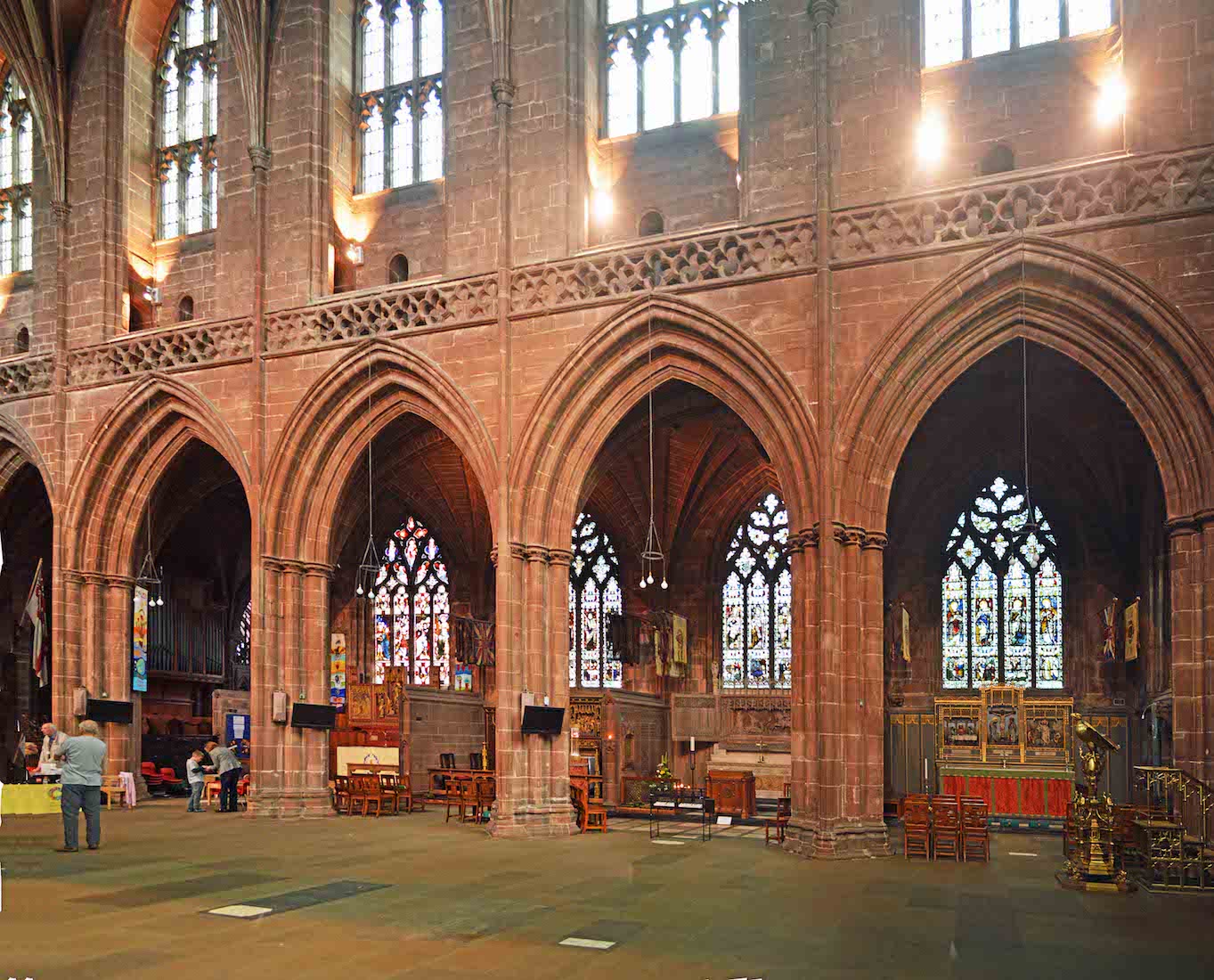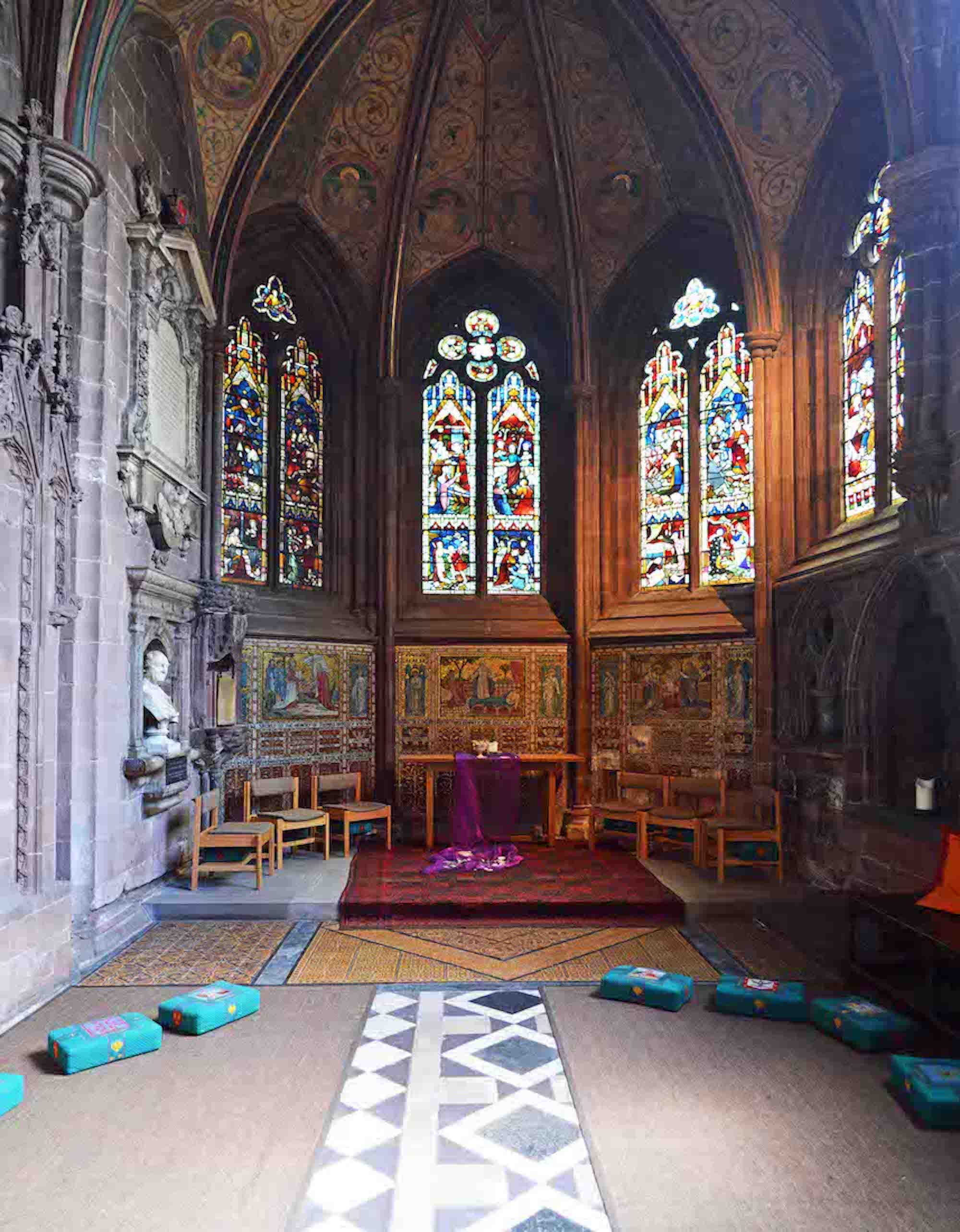
We now come to the Chapel of St Erasmus. A curious design feature of Chester Cathedral means that we have to cross in front of the sanctuary to get here. For some reason the South quire aisle was shortened by architect Gilbert Scott in 1870, and the St Erasmus Chapel added. PLAN
82. CHAPEL CEILING
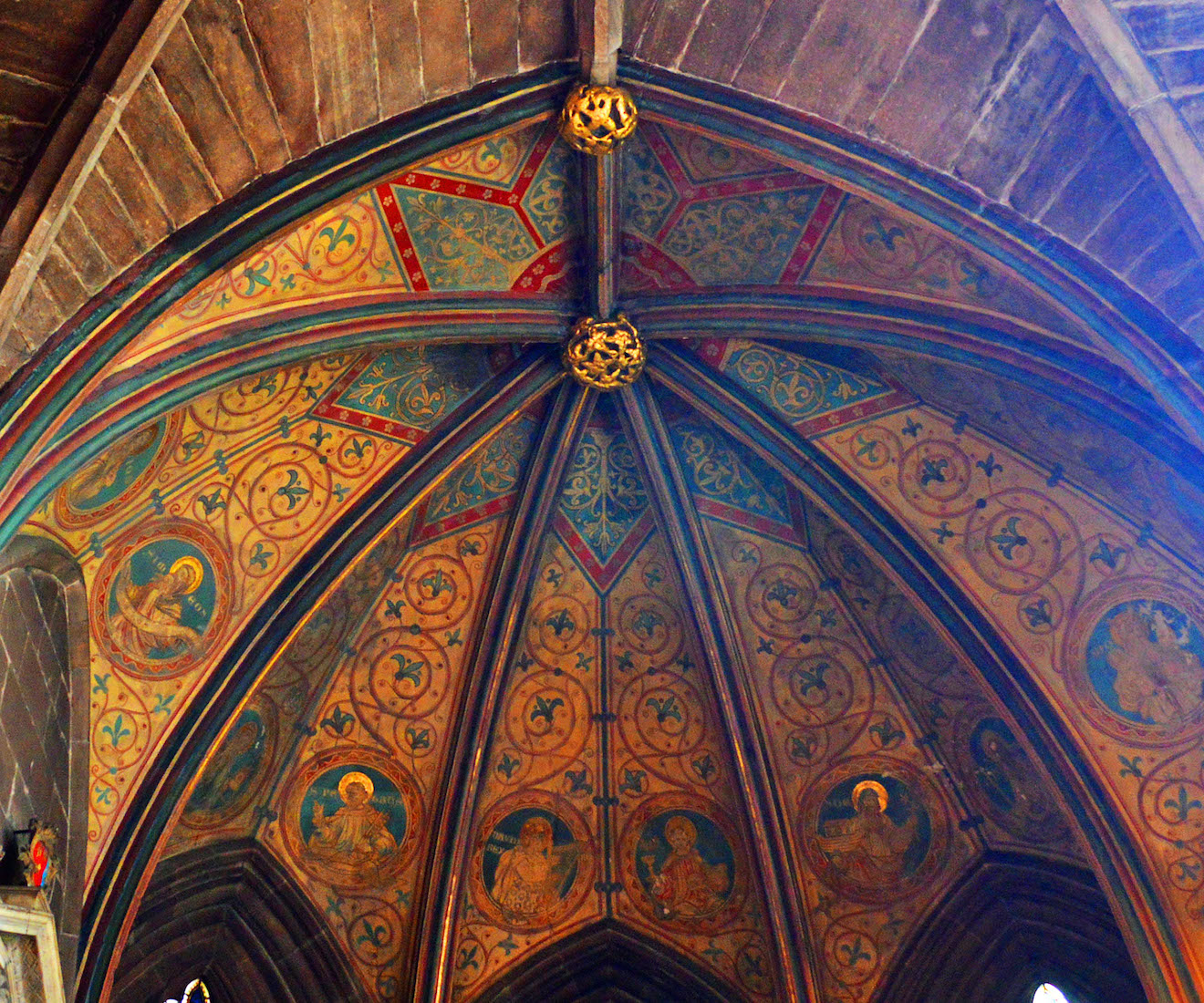
The Erasmus Chapel is dedicated to the patron saint of sailors, also known as St Elmo, and is set aside for private prayer. The stone vaulting, the stained glass, and the mosaic behind the altar form a single symbolic scheme representing the five virtues of Faith, Hope, Charity, Humility and Patience.
83. THOMAS BRASSEY MEMORIAL
The bust of railroad contractor Thomas Brassey (1805-70) stands at the left of this chapel. On the back wall are three 1879 Salviati mosaics designed by Clayton and Bell. These are dedicated to the memory of Thomas and his wife Maria Farringdon Harrison (d. 1877) by their sons Thomas, Henry Arthur (Harry) and Albert Brassey. Thomas the younger had built the Brassey Institute in Hastings.
84. CHAPEL WINDOWS
These four windows are found in the Erasmus Chapel. From left to right they illustrate the texts: ‘Now we see through a glass darkly, but then face to face’; ____ ; ‘When that which is perfect is come, that which is in part will be done away’; ‘Now abideth faith, hope, charity, but the greatest of these is charity’.
85. SOUTH QUIRE AISLE
We leave the Erasmus Chapel, and walk West along the South quire aisle.
86. SOUTH QUIRE AISLE LOOKING WEST
We can admire the stone vaulting and the stained glass windows, and notice the plaques along the wall, but unfortunately the aisle itself is a mess! Despite their large size, cathedrals generally seem to have storage problems.
87. SOUTH QUIRE AISLE WINDOWS
There are three large stained glass windows along this aisle. Allowing for some guesswork(!) these show from left: the Risen Christ and Christ’s miracles; four scenes about the disciples going out into the world, from Peter receiving the Keys of the Kingdom, to a commissioning; four parables – the fishing net, the prodigal son, the stewards and talents, the good Samaritan.
88. SOUTH TRANSEPT
In contrast to the North transept, this transept is large and spacious. In fact, it is the largest transept of any English cathedral. There are stained glass windows all around, including a large window in the South wall. And along the East wall are four chapels.
89. LEGO MODEL
In a money-raising venture for the Cathedral, visitors are invited to buy a brick to contribute to this scale model. This is a great idea, and has been used elsewhere. We begin our investigation of the South transept by checking out the chapels along the East wall.
90. ST MARY MAGDALENE CHAPEL
This chapel is sometimes known as ‘the Children’s Chapel’, and there are signs of youthful activity! The warlike scenes in the window of this chapel do not really fit with the Magdalene theme. But above the altar is a beautiful triptych with the Risen Christ, and scenes of Mary Magdalene washing the feet of Jesus, and meeting him after his resurrection.
91. ST OSWALD’S CHAPEL
For many years the South transept served as the Parish Church of St Oswald, being separated from the rest of the Cathedral. Now there is this chapel. The window has four main panels depicting from left King Saul(?), St Peter, St John (?) and King David. The magnificent reredos shows the seventh-century Northumbrian king and saint, Oswald, who converted to Christianity after a victory in battle. Regimental colours hang from above. Charles Kempe designed the reredos and window.
92. ST GEORGE’S CHAPEL
This is an impressive chapel with a wide solid altar and reredos showing George slaying the dragon. Regimental colours of the 22nd Cheshire Regiment hang from above, and there is a four-light window depicting four saintly bishops. There are corresponding, nearly illegible labels: I think one of them is St Asaph.
93. ST NICHOLAS’S CHAPEL
This is another chapel with an impressive altar and reredos. This reredos shows the Last Supper, the Crucifixion, and Jesus appearing from the tomb. The four saints depicted in the window are from left: St Stephen, St Catherine, St Margaret and St Leonard. Again, there are regimental colours hanging above.
94. THE TRANSEPT CHAPELS
Standing back, we can look across the transept to see the chapels in context behind the row of gothic arches.
95. TRANSEPT SOUTH WALL
There are three stained glass windows across the South wall of this transept, and we look at them shortly. But below, there is a very impressive brass eagle lectern with a flight of steps leading up to the eagle. The eagle is standing on a dragon (the triumph of the Word over Satan) and the Four Evangelists stand below. And under the main window stands an altar surrounded by a number of memorial plaques.
96. TRANSEPT SOUTH WINDOWS
The lights of the left window form a composite scene of Jesus and the centurion. The main window shows the crucifixion with the glorified Christ above and with surrounding crowds. Underneath are a number of Old Testament scenes. The right window is a dramatic picture of Christ with the words ‘I am alive forever more’. Underneath is Chester Cathedral with ‘St Werburgh’ close by.
97. TRANSEPT WEST WALL
We turn our attention to the West side of the transept with its own row of gothic arches, stained glass windows, and wall decorated with many memorial plaques. We notice a pedestal standing under the second arch from the left, and a tomb-like monument under the adjacent arch. On the wall beyond the monument is an aeroplane propellor – part of a Royal Airforce memorial.
98. TRANSEPT WEST WINDOWS
One needs a degree to interpret cathedral windows! From the panels in turn, from the left: ‘There was war in heaven’, ‘O grave where is thy victory’, ‘Peace upon earth’, ‘Risen unto Christ’; Fortitude, St George, Obedience, ? ; I have no idea about the third window; St Werburgh, St Henry, St Lucia, St Oswald.
99. PEDESTAL AND ROYAL AIRFORCE MEMORIAL
The pedestal carries the shield and star of the Cheshire Regiment, and supports a book of remembrance with 8417 names of all ranks of the 22nd Regiment who fell in the Great War 1914 – 1919. The Royal Airforce memorial consists of a wooden propellor with RAF Badge, and an inscription: Here therefore pray of your charity for the Royal Airforce and for all who adventure dear lives in the air.
100. DUKE OF WESTMINSTER MONUMENT
This monument dates from 1902 and remembers the first Duke of Westminster. It was designed by Charles Blomfield in medieval style. The Duke’s feet are resting on a hunting dog known as a ‘talbot’, a breed which is now extinct. This signifies faithfulness and acknowledges the Duke’s interest in hunting. The same breed appears at the four corners of the monument.


